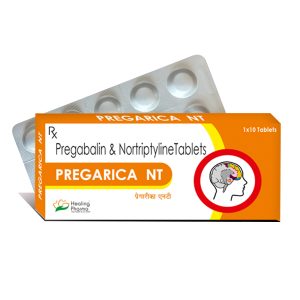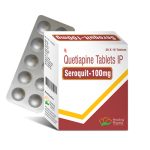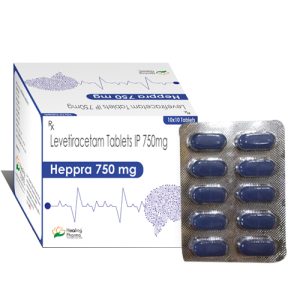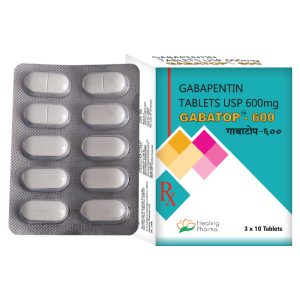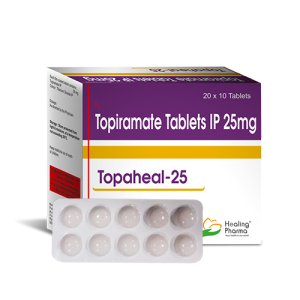| Packaging Size | 10/BOX |
| Brand | SEROQUIT |
| Manufacturer | HEALING |
| Composition | QUITIPINE |
| Treatment | Depression |
| Prescription/Non prescription | Prescription |
Quetiapine (Seroquit 100) 100 mg tablet is a second-generation atypical antipsychotic used to treat and relieve symptoms common in schizophrenia, bipolar disorder, and shallow depression. These include distorted thinking and emotional instability.
Drug =Quetiapine
Number of Pills Per Order = 10
Strength = 100 mg
Manufacturer = Healing Pharma
How To Take
Quetiapine is maybe available as conventional tablets and as extended-release tablets. Take this medicine at about the same time each day.
If you have been given the conventional tablet, you may take it with or without food.
If you are taking an extended-release tablet (usually marked as “XL” or “XR”), take it on an empty stomach without food or with a light meal (<300 calories). Do not cut, chew, or crush this tablet. Swallow it whole with a glass of water.
Quetiapine must be taken regularly for it to be effective. Continue taking this medicine even when you feel better. Do not stop taking it unless instructed otherwise, as stopping it suddenly could worsen your condition.
Take Quetiapine precisely as directed by your doctor or according to the instructions on the label. Do not take more or less than instructed by your doctor.
Dosage of Quetiapine (Seroquit 100) 100 mg
Adult: Schizophrenia: As immediate-release/film-coated tab: Initial: 25 mg twice a day on day 1, followed by 50 mg twice a day on day 2, 100 mg twice a day on day 3 and 150 mg twice a day on day 4. Titrate dose according to response between 300-450 mg daily given in 2 divided doses from day four onwards. Maximum dose of 750 mg daily. As extended-release tab: 300 mg once daily on day 1, followed by 600 mg once daily on day 2. Adjust according to patient response between 400-800 mg daily. Usual dose: 600 mg once daily. Maximum dose of 800 mg daily.
Acute manic episodes of bipolar disorder: As immediate-release/film-coated tab: 50 mg twice a day for day 1, followed by 100 mg twice a day for day two than 150 mg twice a day on day 3 and 200 mg twice a day on day 4. Adjust in increments up to 200 mg daily according to the response. Usual dose: 400-800 mg daily in 2 divided doses. Maximum dose of 800 mg daily. As an extended-release tab: 300 mg once daily on day 1, followed by 600 mg daily on day two, adjusted according to the response. Usual dose: 400-800 mg once daily. The depressive phase of bipolar disorder: As immediate-release/film-coated/extended-release tab: 50 mg once daily on day 1 to be taken at bedtime, followed by 100 mg once daily on day 2, then 200 mg once daily on day 3 and 300 mg once daily on day 4. Adjust according to patient response. The usual dose is 300 mg once daily—a maximum dose of 600 mg daily.
Prevention of bipolar disorder: As immediate-release tab/film-coated: Continue at the dose useful for the treatment of bipolar disorder and adjust to the lowest effective dose. The usual dose is 300-800 mg daily in 2 divided doses. As extended-release tab: Continue at the dose active for the treatment of bipolar disorder and adjust to the lowest effective dose. Usual dose: 300-800 mg once daily.
Major depressive disorder In combination with other drugs: As extended-release tab: 50 mg once daily for days 1 and 2, dose to be taken at bedtime, followed by 150 mg once daily for days 3 and 4, then adjusted according to the response. The usual dose is 150-300 mg once daily.
Missed Dose
If you miss a dose, skip the missed dose and return to your regular dosing schedule. If you often forget to take your medicine, let your doctor and pharmacist know.
Do not double a dose under any circumstances.
Overdose of Quetiapine (Seroquit 100) 100 mg
Signs of overdose may include the following:
- Drowsiness
- Sedation
- Tachycardia
- Hypotension
- Anticholinergic effects
- QT prolongation
- Seizures
- Status epilepticus
- Rhabdomyolysis
- Respiratory depression
- Urinary retention
- Confusion
- Agitation
- Delirium
- Coma
Seek medical help immediately.
Contraindications
People with the following medical conditions should not take Quetiapine:
- Concomitant use with CYP3A4 inhibitors
Side Effects
Quetiapine may have the following side effects:
- Anticholinergic effects
- Blood dyscrasias
- Esophageal dysmotility
- Aspiration
- Extrapyramidal symptoms
- Withdrawal symptoms
- Orthostatic hypertension
- Hyperlipidemia
- Hyperprolactinemia
- Anaphylactic reactions
- Hypothyroidism
- Weight gain
- Cataracts
- Impaired body temperature regulation
- Pancreatitis
- Venous thromboembolism (VTE)
- Constipation
- Cardiomyopathy
- Myocarditis
- Dysphagia
- Constipation
- Intestinal obstruction
- Decreased hemoglobin
- Tachycardia
- Palpitation
- Decrease T3 and T4
- Increase TSH
- Blurred vision
- Dry mouth
- Constipation
- Dyspepsia
- Vomiting
- Mild asthenia
- Irritability
- Pyrexia
- Increased serum transaminases
- Serum triglyceride elevations
- Total cholesterol elevation
- HDL decrease
- Increase appetite
- Peripheral edema
- Dizziness
- Somnolence
- Headache
- Abnormal dreams and nightmares.
- Dyspnea
- Rhinitis
- Nasal congestion
- Suicidal ideation and behavior
- Neuroleptic malignant syndrome
- Hyperglycaemia and development or exacerbation associated with
- Ketoacidosis or coma
- Severe neutropenia
- Agranulocytosis
- QT prolongation
Warnings
Do not use Quetiapine in the following conditions:
- Elderly patients with dementia-related psychosis.
Inform your doctor and pharmacist if you are taking any of these medicines:
- Ritonavir
- Saquinavir
- Indinavir
- Ketoconazole
- Itraconazole
- Fluconazole
- Erythromycin
- Clarithromycin
- Nefazodone
- Lorazepam
- Thioridazine
- Phenytoin
- Carbamazepine
- Rifampicin
- Levodopa
- St. John’s wort
Inform your doctor and pharmacist if you are taking any other medicines, including herbal tonics such as traditional Chinese medicines, supplements, and non-prescription medicines.
This list does not include all medicines that may interact with Quetiapine.
How Does Quetiapine (Seroquit 100) 100 mg Work?
Quetiapine is a dibenzothiazepine atypical antipsychotic agent that has an affinity for serotonin (5-HT2), histamine (H1), adrenergic (α1 and α2) and dopamine (D1 and D2) receptors. Its clinical antipsychotic properties and low extrapyramidal side effects are mediated through antagonizing a combination of D2 and 5-HT2 receptors.
Uses
Quetiapine is used to treat the following conditions:
- Schizophrenia
- Acute manic episodes of bipolar disorder
- The depressive phase of bipolar disorder
- Prevention of a bipolar disorder
- Major depressive disorder
Special Precautions and Connected Warnings
Take special precautions if you have the following conditions:
- Patient at risk of seizures (e.g., head trauma, brain damage)
- with Lewy body dementia
- Parkinson disease dementia
- Cardiovascular disease or cerebrovascular disease
- Conditions predisposing to hypotension
- At the risk of QT prolongation (e.g., heart failure, cardiac myopathy)
- Urinary retention
- BPH
- Increased intraocular pressure
- Alzheimer’s disease
- Diabetes
- Hyperlipidemia
- Breast cancer or other prolactin-dependent tumors
- History of alcohol or drug abuse
- Behavioral changes and increased risk of suicidal thinking
- Avoid abrupt withdrawal
- They are not intended for treatment in elderly patients with dementia-related psychosis.
- Renal and hepatic impairment
- Elderly. Pregnancy and lactation
- Avoid alcohol.
Storage Conditions
- Store between 20-25°C.
- Store in a cool, dry place away from the reach of children.
- Do not use Quetiapine that is expired or out of date.


